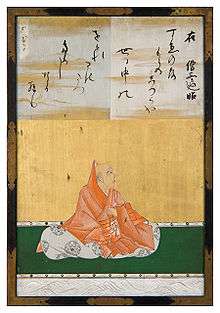Henjō
Yoshimine no Munesada (良岑宗貞), better known as Henjō (遍昭 or 遍照, 816 – February 12, 890) was a Japanese waka poet and Buddhist priest.

Thanks to a reference to him in the preface of Kokin Wakashū, he is listed as one of the six best waka poets and one of the thirty-six immortals of poetry.
Biography
Munesada was the eighth son of Dainagon Yoshimine no Yasuyo (良岑安世), a son of Emperor Kanmu who was relegated to civilian life.[1] He began his career as a courtier, and was later appointed to the position of kurōdo, a sort of Chamberlain, of Emperor Ninmyō. In 849, he was raised to the Head of Kurōdo (蔵人頭, Kurōdo no Tō). After Emperor Nimmyō died in 850, Munesada became a monk out of his grief, taking the religious name Henjō (literally “Universally Illuminated”).
He was a priest of the Tendai school. In 877 he founded Gangyō-ji (元慶寺) in Yamashina, in the southeast part of Kyoto, but continued to be active in court politics.[2] In 869 he was given another temple, Urin-in or Unrin-in (雲林院), in the north of Kyoto and managed both temples. In 885 he was ranked high priest and was called Kazan Sōjō (花山僧正).
He was rumored to have had a love affair with the famous female poet Ono no Komachi.
Thirty-five of his waka were included in the imperial anthologies of waka including Kokin Wakashū. In the preface Ki no Tsurayuki criticized him: “he knows how to construct waka, but there is less real emotion. It is like when you see a picture of a woman and it moves your heart”.
His son, Sosei, was also a waka poet and a monk.
Poetry
Henjō was famous for the following poem from the Hyakunin Isshu:
天つ風雲の通ひ路吹き閉ぢよ
をとめの姿しばしとどめむ
ama tsu kaze kumo no kayoiji fuki-toji yo
otome no sugata shibashi todomen
Breezes of Heaven, blow closed the pathway through the clouds to keep a little longer these heavenly dancers from returning home.[3]
(Kokin Wakashū 17:872)
References
- Bowring, Richard (2005). The Religious Traditions of Japan 500-1600. p. 164.
Henjō, being himself the grandson of Kanmu Tenno, was another frequenter of the court, famous as a waka poet; but much of his time from 876 onwards was devoted to the establishment of the Gangyō-ji near the capital.
- Adolphson, Mikael S.; Kamens, Edward; Matsumoto, Stacie (2007). Heian Japan: Centers and Peripheries. pp. 217–18.
'not disassociate himself' or his temple Gangyōji, founded in the 860s in the hills just east of Kyoto, from the court, but rather... [o]ne of Kōkō's supporters was the aforementioned Tendai monk Henjō, who was given an opportunity to disrupt Fujiwara ... post (sōjō) within the Office of Monastic Affairs in 886 and allowed rare privileges and influence at the imperial court.
- Fujiwara, Teika (2018). One Hundred Poets, One Poem Each: A Treasury of Classical Japanese Verse. Translated by MacMillan, Peter. Penguin UK. ISBN 9780141395944.